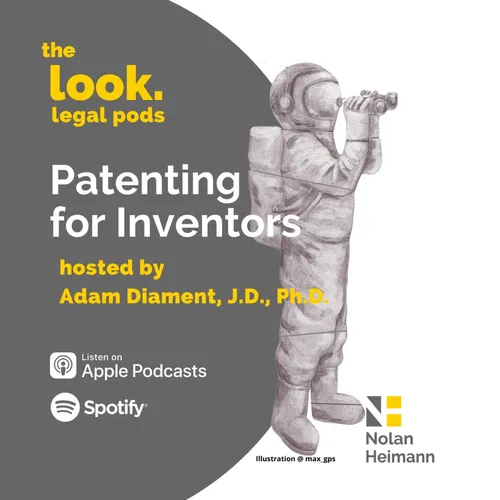
Patenting for Inventors
Learn the steps of how to patent your invention, from initial concept to issued patent. Host and registered patent attorney, Adam L. Diament, J.D., Ph.D., guides you through the complicated process of patenting your invention. This podcast starts from the beginning of what to do when you first have an idea, all the way through the steps that lead to an issued patent. Other intellectual property areas will also be covered, such as trademarks, copyrights, trade secrets, and licensing. Adam Diament is a partner at the law firm of Nolan Heimann LLP.
- Update frequency
- every 14 days
- Average duration
- 9 minutes
- Episodes
- 168
- Years Active
- 2017 - 2025

How to Get Your Patent Term Extended. EP067
Generally patents last 20 years from the date of filing, but in some situations they can be extended past this date. Check out this episode to learn about the situations where your patent term can b…

How to Conduct a Patent Examiner Interview. EP066
In this episode I talk about how to conduct a patent examiner interview. I go over how to schedule one, what to do during an interview and what to do after an interview, as well as some patent interv…

How to Revive a Patent or Patent Application. EP065
Sometimes your patent or patent application goes abandoned because you didn't respond to a rejection in time or you didn't pay the right amount fees to the patent office. What should you do? Learn th…

Patent Appeals - How and When to Appeal. EP064
If your patent examiner keeps rejecting your application, what should you do? One option is to appeal to the Patent Trial and Appeal Board (PTAB). Learn what an appeal is, and how to do one.

Bonus Episode 01: Genein Letford Interview
In this bonus episode of "Patenting for Inventors," I interview Genein Letford, author, educator, and founder of Alumni360, an entrepreneurship mentoring program for college bound students.

Should I File a Pre-Appeal Brief Conference Request? EP063
There are several options for responding to a Final Office Action. One option is to file a Pre-Appeal Brief Conference Request so that your application is reviewed by additional patent examiners. Le…

Should I File a Request for Continued Examination? EP062
There are several options for responding to a final rejection. In this episode learn how to do one of those options, called a Request for Continued Examination.

Eight Options for Responding to a Final Rejection. EP061
If the claims in your patent application have been rejected twice, you usually will receive a final office action. Don't worry yet! "Final" does not mean final. There are at least eight options you…

What Are Double Patenting Rejections? EP060
You are only allowed one patent per invention, but sometimes you might get a rejection called a "Double Patenting Rejection." What are these and how do you handle them?

What are Continuation-in-Part Patent Applications? EP059
Continuation-in-Part applications are useful for when you have some additional features you want to get patent protection for, but you didn't include them in your original patent application.

What are Continuation Patent Applications? EP058
This episode goes over the specific type of continuing application called a continuation application. Use continuation applications to broaden your patent protection from your original application, k…

What are Divisional Patent Applications? EP057
Learn what divisional patent applications are and when you should file one. Divisional patent applications are useful when the patent examiner has previously required you to split up your originally…

What are Continuing Patent Applications? EP056
If you are considering filing patent applications related to an application that you already filed, then you might be interested in a continuing patent application. There are different types and you …

How to Respond to a Patent Application Election of Species Requirement. EP055
Learn how to respond to an election of species requirement from the patent office. An examiner will not examine your invention if you are claiming too many variations of the same thing. In this epi…

How to Respond to a Patent Application Restriction Requirement. EP054
Learn what a patent application restriction requirement is. A patent application is only allowed to have one invention, so what are you to do if the examiner says that your patent application actual…

How to Amend the Patent Application Specification. EP053
Learn how to amend the patent application specification and the requirements of what to do if you have to do a substitute specification and how to mark up your application with strikethroughs, underl…

How to Amend Patent Drawings. EP052
In this episode I go through how to amend patent drawings.

How to Mark up Your Amended Claims. EP051
In this episode I go through the mechanics of how to mark up any claims that you have amended. Know how to properly use underlining, strikethroughs, and double brackets to tell the examiner what exa…

Claim Amendments - Claim Status Identifiers. EP050
When you amend claims, you can't just send a new set of claims to the patent examiner and ask for a reconsideration, you have to identify and mark up your claims in a specific way. In this episode I …

Obviousness Responses - Secondary Considerations. EP049
In this episode I go through how to respond to obviousness rejections by using secondary considerations. Secondary considerations for non-obviousness include reasons for patentability, including: co…